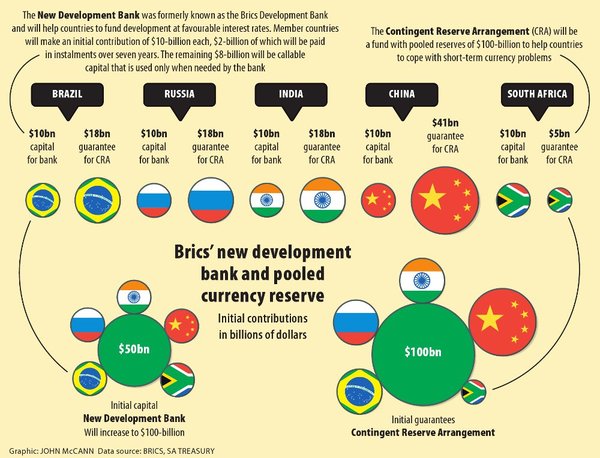Context
- The 11th summit of the BRICS grouping comprising Brazil, Russia, India, China and South Africa was held in Brasilia last week.
- Pitted as a counterweight to G7, the combine of developed economies, BRICS represents the world’s top emerging economies and claims to serve as a bridge between the developed and developing world.
- Questions are also being raised about its efficacy and impact. Its significance for India has also been put to questions several times.
What is BRICS?

- BRICS is an acronym for the grouping of the world’s leading emerging economies, namely Brazil, Russia, India, China and South Africa.
- The BRICS Leaders’ Summit is convened annually. It does not exist in form of organization, but it is an annual summit between the supreme leaders of five nations.
inception
- On November 30, 2001, Jim O’Neill, a British economist who was then chairman of Goldman Sachs Asset Management, coined the term ‘BRIC’ to describe the four emerging economies of Brazil, Russia, India, and China.
- He made a case for BRIC on the basis of econometric analyses projecting that the four economies would individually and collectively occupy far greater economic space and become among the world’s largest economies in the next 50 years or so.
Formation
- The grouping was formalized during the first meeting of BRIC Foreign Ministers on the margins of the UNGA in New York in September 2006.
- The first BRIC Summit took place in 2009 in the Russian Federation and focused on issues such as reform of the global financial architecture.
Members
- South Africa was invited to join BRIC in December 2010, after which the group adopted the acronym BRICS. South Africa subsequently attended the Third BRICS Summit in Sanya, China, in March 2011.
- The Chairmanship of the forum is rotated annually among the members, in accordance with the acronym B-R-I-C-S.
- BRICS now brings together five economies accounting for 42% of the world’s population, 23% of the global GDP and an around 17% share of world trade.
- The five BRICS countries are also members of G-20
- The group at each summit elects one of the heads of state of the component countries to serve as President Pro Tempore of the BRICS. This year it was Brazil.
Financial Architecture of BRICS

Currently, there are two components that make up the financial architecture of BRICS, namely:
- the New Development Bank (NDB) or sometimes referred to as the BRICS Development Bank and
- the Contingent Reserve Arrangement (CRA).
- Both of these components were signed into a treaty in 2014 and became active in 2015.
New Development Bank
- The proposed NDB or the BRICS Development Bank is a multilateral development bank operated by the BRICS states.
- The bank’s primary focus of lending will be infrastructure projects with authorized lending of up to $34 billion annually.
- South Africa will be the African Headquarters of the Bank named the “New Development Bank Africa Regional Centre”.
- The bank will have starting capital of $50 billion (members contributing $10 billion each) with capital increased to $100 billion over time.
BRICS CRA
- The BRICS Contingent Reserve Arrangement (CRA) is a framework for providing protection against global liquidity pressures.
- This includes currency issues where members’ national currencies are being adversely affected by global financial pressures.
- It is found that emerging economies that experienced rapid economic liberalization went through increased economic volatility, bringing uncertain macroeconomic environment.
- The CRA is generally seen as a competitor to the International Monetary Fund (IMF) and along with the New Development Bank is viewed as an example of increasing South-South cooperation.
- It was established in 2015 by the BRICS countries. The legal basis is formed by the Treaty for the Establishment of a BRICS Contingent Reserve Arrangement, signed at Fortaleza, Brazil on 15 July 2014.
Significant feats of BRICS
I. Johannesburg Declaration, 2018
- The 2018 summit saw the BRICS leaders come together and discuss various international and regional issues of common concern and adopted the ‘Johannesburg Declaration‘ by consensus.
- It implies that this important multilateral grouping has a lot to say about the state of the world.
- The leaders jointly reaffirmed their commitment to the principles of mutual respect, sovereign equality, democracy, inclusiveness and strengthened collaboration.
- The BRICS leaders have used the summit to reject the growing unilateralism and instead reiterate their commitment to the strengthening of multilateral institutions, calling for stronger intra-trade within member states.
II. Focus on New Industrial Revolution
- The other big idea emanating from the summit is to help nations to prepare for the Fourth Industrial Revolution.
- Participants embraced it, articulating the need for a new strategy on employment, education and skill development as the digital revolution unfolds.
- The leaders commended the establishment of the BRICS Partnership on New Industrial Revolution (PartNIR).
- The BRICS Partnership on New Industrial Revolution (PartNIR) aims to deepen BRICS cooperation in digitalisation, industrialisation, innovation, inclusiveness and investment and to maximise the opportunities and address the challenges arising from the 4th Industrial Revolution.
III. BRICS Plus
- The BRICS outreach to Africa began at the last summit hosted by South Africa, in 2013.
- It has picked up momentum now but African leaders want more
- They need big loans from the New Development Bank (NDB) for their infrastructure projects
- China introduced the “BRICS Plus” format at the Xiamen summit last year by inviting a few countries from different regions.
- South Africa emulated it, arranging the attendance of top-level representation of five nations of its choice: Argentina, Jamaica, Turkey, Indonesia and Egypt
- The precise role of “BRICS Plus” countries will take time to evolve but an immediate benefit is the immense opportunities it provides for networking among leaders.
IV. Brasilia outcome
- During Brazil’s chairmanship, the grouping reported 30 new outcomes, initiatives and documents.
- The latest summit needed a 73 para-long Brasilia Declaration to spell out the leaders’ shared worldview and spectrum of their work.
- Much to India’s satisfaction, the commitment of BRICS to counterterrorism seems to be getting strengthened.
- Its working group on countering terrorism has expanded its activities through five thematic subgroups that deal with terrorist financing, use of Internet for terrorist purposes, countering radicalization etc.
- Where the BRICS shows signs of advancing is in the economic domain. Here, five facets need to be highlighted.
V. NDB projects
- The New Development Bank (NDB), the grouping’s flagship achievement, has 44 projects with its lending touching $12.4 billion, in just five years.
- This is not a small gain, but the bank needs to grow as “a global development finance institution”. A move is now afoot to open its membership selectively.
- NDB has opened its regional centres in South Africa and Brazil, and will do so in Russia and India in 2020.
VI. Local currency Bond Fund
- With a successful Contingent Reserve Arrangement in the bag, BRICS governments are set to establish a local currency Bond Fund.
- But the earlier proposal to launch a credit rating agency remains shelved due to internal differences.
VII. Business promotion
- Business promotion among member-states has been accorded a new salience.
- The BRICS Business Council held a substantive dialogue to foster cooperation in areas ranging from infrastructure and energy to financial services, regional aviation and digital economy.
- Its cooperation with the NDB is being encouraged. The national trade promotion agencies signed an MoU on cooperation among themselves.
- A BRICS Women Business Alliance was also created, both as a women empowerment measure and as a tool to bring “a distinctive perspective on issues of interest for the business community.”
VIII. Commitment on NIR
- Following up on the decisions taken at the previous summit, operationalisation of the Partnership on New Industrial Revolution is underway.
- It is focused on cooperation in digitalisation, industrialisation, innovation, inclusiveness and investment.
- This partnership will be concretized by establishing industrial and science parks, innovation centres and business incubators.
Relevance of BRICS
There are three major factors that threaten the relevance of the BRICS grouping and render it just another multilateral grouping in an already bloated set of groupings:
I. Political
- These countries are not all on the same page at the same time. While India and Russia share historically close ties, India-China relations experience swing from warm to frosty and back like a pendulum.
- Russia and China have been united by a common adversary. US-led West-imposed sanctions on Russia and Washington and Beijing’s trade war have pushed the world’s second and third-largest military powers closer together.
II. Economic
- There isn’t much convergence. From being four economies to watch out for back in 2001, they (along with South Africa) are all in the middle of some sort of economic doldrums.
- But the reasons for the states of these economies vary vastly.
- BRICS can be broken into two groups — those that took advantage of globalization’s march to integrate themselves into global supply chains (primarily China and India).
- The other faction includes those that took advantage of globalization to sell their abundant natural resources (primarily Brazil, Russia and South Africa).
III. Strategic
- A small positive, if that, is that it gives India one more mechanism, occasion and opportunity to hold dialogue with China.
- There may be little tangible movement in India-China ties, however, if diplomacy is to work, sustained interaction between parties is essential.
- A counterpoint to this point, however, is that India and China already have several points of contact bilaterally and multilaterally (at the UN, SCO, East Asia Summit etc.) and that one extra platform isn’t going to make a whole lot of difference.
- Perhaps that is true, but the glorified talk-shop that discusses “futuristic subjects” that is BRICS will continue to exist despite its irrelevance, and any little benefits it affords should be appreciated.
IV. People-to-People exchange
- BRICS members have recognised the need for strengthening People-to-People exchanges and to foster closer cooperation in the areas of culture, sport, education, film and youth.
- People-to-People exchanges seek to forge new friendships; deepen relations and mutual understanding between BRICS peoples in the spirit of openness, inclusiveness, diversity and mutual learning.
- Such People to people exchanges include the Young Diplomats Forum, Parliamentarian Forum, Trade Union Forum, Civil BRICS as well as the Media Forum.
India’s position amongst BRICS
- Eighteen years later, India finds itself as one of the emerging economies in the grouping and beyond, especially
- As PM Modi attends the 11th BRICS Summit in Brasilia, his sixth since he assumed office in 2014, it will be the beginning of what New Delhi sees as the “second cycle” of BRICS.
- From the Indian perspective, BRICS has emerged the voice of developing countries or the global south.
- As these countries face an aggressive club of developed countries, raising challenges on issues from WTO to climate change, India believes BRICS has to protect the rights of the developing countries.
- Also, India has to maintain the balancing act between Russia-China on the one side and the US on the other.
India’s successes
- The fact that BRICS has put counter-terrorism on top of the agenda has been a success for India.
- That was evident in the BRICS Summit in Xiamen in September 2017, with China as the chair.
- The fact that it was achieved, despite the strained ties due to the standoff in Doklam, was a testimony to the value Beijing and New Delhi attach to the outcomes of the grouping.
- On the question of multilateralism, India has articulated a vision for strengthening and reforming the multilateral system itself.
- When India calls for multilateralism, it is not a call to reinforce the status quo of multilateralism but to reform it since this is what BRICS had originally set out to do.
Challenges confronting India at the BRICS
Some of the crucial challenges are:
I. China’s massive economic weight in the forum
- Its GDP at nearly $12 trillion is now more than twice that of the other four members put together.
- This has changed the internal balance in the BRICS in favour of Beijing.
II. China led Globalization
- Apprehension about US-led globalization was one of the motivations behind India’s quest for a multipolar world in the past.
- But India is now struggling with the issue of China-led globalization. The Belt and Road initiative has added to India’s concerns about China’s rise.
Major disappointments at BRICS
- Despite of the Brasilia Outcome it is difficult to identify new elements in the BRICS’s endeavour to strengthen and reform the multilateral system.
- The “urgent need” to reform the UN, the World Trade Organization, the International Monetary Fund and other international organisations was stressed once again, even as little progress has occurred on this score.
- Interest in open and free trade was reiterated, despite growing protectionist tendencies.
- On the expansion of the UN Security Council, BRICS exposed its disunity yet again by sticking to the formulation that refuses to go beyond China and Russia supporting the “aspiration” of Brazil, India and South Africa.
A critical evaluation
- Overall, while the BRICS grouping may have completed a decade, it continues to face the challenges of the lack of a binding ideology, bilateral differences, diversity in terms of socio-cultural and political systems, and China’s overwhelming presence, which reduces the space for other countries in the grouping.
- It has transformed into an amorphous collective with its fingers in all sorts of pies, but an inability to commit to very many common goals.
I. Goals yet not clear
- The contribution of BRICS to project the perspectives of developing economies is laudable.
- However, by hosting outreach meetings with countries in its neighbouring (or broader) region, each chair (with Brazil’s exception) gave the impression that BRICS would do more for them.
- But the NDB has been lagging behind on this score. It needs to start extending loans for projects in non-BRICS countries to create a solid constituency of supporters.
- Also, is such a plethora of meetings really essential? Do the results justify the expenditure? India’s representatives should ask, do they help the poor and vulnerable sections of the BRICS community?
- Finally, BRICS should ponder if in the short term it needs to focus on fulfilling existing commitments instead of taking on new ones.
II. Namesake consensus against Terrorism
- In 2016, it was noted that successive declarations by the BRICS nations tended to echo the same throwaway lines on terrorism, but do little about assuaging one another’s real concerns.
- The 2019 iteration is no different with its “We condemn terrorism in all its forms and manifestations, which should not be associated with any religion, nationality or civilisation…”.
- Through it all, China continues to show brazen disregard to India’s concerns about terrorism emanating from Pakistan. This is unlikely to change anytime soon.
III. Kindleberger Trap
- As China rises and positions itself as the sole challenger to American hegemony, there is a growing discussion about the possible Kindleberger Trap.
- This is a situation where China may fail to provide global public goods like a clean environment and financial stability, despite being a superpower.
- Small countries have little incentive to contribute to global public goods and it is generally the responsibility of great powers to provide global governance.
- The idea of the Kindleberger Trap is also applicable to rising powers like India, which have global ambitions.
IV. Climate at peril
- Climate governance too has been highlighted as an area where BRICS members have a lot of potential to contribute, but so far, that has not happened.
- Russia has been ambivalent towards climate change and has recently joined the Paris Agreement.
- India has taken initiatives outside the grouping to project itself as a leader in the fight against climate change, such as the launch of the International Solar Alliance in 2015 with France.
- Apart from the global agenda, BRICS allows New Delhi to send out messages about its foreign policy priorities, underscoring its desire to be part of issue-based coalitions.
Way Forward
- A close examination of India’s record in BRICS reveals that New Delhi has used its membership to make a substantial contribution to the global financial architecture, while also making efforts to address glaring gaps in areas such as counter-terrorism, the fight against climate change and UNSC reform.
- India is not a free-rider in a system of global governance dominated by the West, and continues to provide a vision of global governance.
- The BRICS needs to expand its agenda for increasing its relevance in the global order. As of now, climate change and development finance, aimed at building infrastructure must dominate its agenda.
- For BRICS to remain relevant over the next decade, each of its members must make a realistic assessment of the initiative’s opportunities and inherent limitations.
References
https://www.civilsdaily.com/news/op-ed-snap-the-big-five-at-10/
https://www.thehindu.com/opinion/op-ed/brics-on-the-ball/article30009282.ece
https://www.orfonline.org/research/india-and-its-brics-dilemmas-57891/


